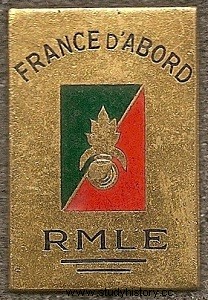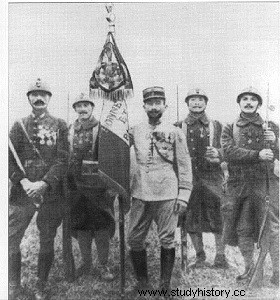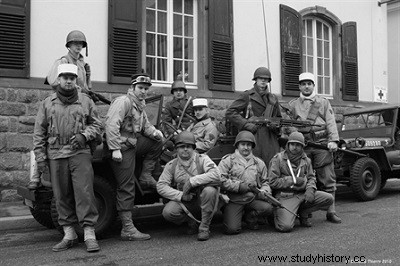
The Marching Regiment of the Foreign Legion (RMLE) was a French military unit of the Foreign Legion.
It was created on November 11, 1915 by merging the 2nd March of the 1st Foreign and the 2nd March of the 2nd Foreign (71 officers and 3,315 non-commissioned officers, corporals and legionnaires).
It is also the first regiment of the French army to receive the fourragère in the colors of the Military Medal.
Creation and different denominations
On November 11, 1915, the Marching Regiment of the Foreign Legion was created from the survivors of the 2nd Marching Regiment of the 1st Foreign and those of the 2nd Marching Regiment of the 2nd Foreign.
November 15, 1920 , the RMLE became the 3rd Foreign Regiment (3rd RE) by change of name.
On June 20, 1922, it became the 3rd Foreign Infantry Regiment (3rd REI).
On December 5, 1942, a half-brigade of the Foreign Legion and colonial infantry was created from personnel of the 3e REI. On December 15 of the same year, it became the 3rd Foreign Marching Infantry Regiment (3e REIM).
On July 1, 1943, the 3e REIM became the RMLE again.
At the end of the war, on July 1, 1945, the regiment resumed its name of 3e REI.
History of garrisons, campaigns and battles
First World War

During the First World War, the RMLE fought within the Moroccan Division alongside the 4th and 7th RTA as well as the 8th RMZ.
1914
August 1914 - The genesis of the regiment
The RMLE is the heir of the four marching regiments formed at the start of the war. Faced with the influx of foreign volunteers, the 1st foreign regiment of Sidi Bel-Abbès and the 2nd foreign regiment of Saida, stationed in Algeria, set up four half-battalions intended to constitute the backbone of future regiments:
2nd Marching Regiment of the 1st Foreign;
3rd Marching Regiment of the 1st Foreign;
4th Marching Regiment of the 1st Foreign;
2nd Marching Regiment of the 2nd Foreign.
The recruits come from all over France where different depots have been created (Toulouse, Montélimar, Paris, Nîmes, Lyon, Avignon, Bayonne and Orléans) and include 51 different nationalities. About (32,000 foreigners were enrolled in the marching regiments of the Foreign Legion between August 1914 and April 1915, the largest contingent was Italian and made it possible to form an entire regiment (3rd marching 1st foreigner), however other nationalities :Russian, Swiss, Belgian, Polish, Czech, Spanish, German, Turkish, Luxembourgish and English are also very represented.
1915
These four regiments were present on the front from the end of 1914 to the end of 1915 and distinguished themselves in particular in Argonne (December 1914), in the Somme and Craonne (winter 1914-1915), in Artois (May 1915) and finally in Champagne ( September 1915).
On November 11, 1915, the two surviving regiments, the 2nd marching regiment of the 1st foreign and the 2nd marching regiment of the 2nd foreign, merged and became the marching regiment of the foreign legion.
Officers of the foreign regiment , in the center with his stick Peppino Garibaldi, January 1915.
1916
July 1916 - Somme
The RMLE, then made up of 3 battalions with 4 companies, took part in the Battle of the Somme.
Corps Commander Lt. Colonel Cot
1st Battalion:Commander Ruelland (killed July 9)
2nd Battalion:Commander Waddell
3rd Battalion:Commandant Mouchet (killed on July 6)
On July 4 during the capture of Belloy-en-Santerre, the 3rd battalion was annihilated and lost its commander. It was during this fight that the American poet Alan Seeger was killed, engaged in the Foreign Legion for the duration of the war and author of the poem “I Have A Rendezvous With Death” On July 7, the 1st battalion attacked the gut of Chancellor and in turn loses its leader. In mid-July, the regiment, which only had 3 companies per battalion, was withdrawn from the front to reconstitute itself. From July 4 to 9 he lost (1,368 men out of 3,000 (Officers:(14 killed and (22 wounded - Legionnaires - (431 killed or missing and (901 wounded).
1917
April 1917 - Auberive
Corps Commander Lt. Colonel Duriez (killed April 17)
1st Battalion:Commandant Husson de Sampigny
2nd Battalion:Commandant Waddell
3rd Battalion:Commander Deville then Captain Lannurien
The battle, which took place from April 17 to 21, resulted in the putting out of action of half of the 1,500 RMLE legionnaires and the loss of the corps commander, who was replaced by Commander Deville.
August 1917 - Verdun
Corps Commander Lt. Colonel Rollet
1st Battalion:Commander Husson de Sampigny
2nd Battalion:Commander Waddell
3rd Battalion:Commander Deville
On August 20, the regiment is responsible for counterattacking in order to relieve the city. In front of him 4 enemy regiments are entrenched. On the 21st all the objectives were achieved, the RMLE perforated the front 3.5 kilometers deep. It was during this feat of arms that he won his 6th citation at the order of the army and shortly after obtained the Legion of Honor for his flag.
1918
April 1918 - Hangard Wood
The 131st Infantry Division is marching against the village of Hangard and Hill 99. Even if the German offensive is not a surprise, there is still an urgent need to contain it as well as possible. The Moroccan Division launches into the battle without having had the possibility of preparing its counter-attack. The Marching Regiment of the Foreign Legion is engaged on the right wing of the division. His target is Hangard Wood. The German response is infernal, In the woods, it's hell, the enemy fire does not slow down for a second. The survivors of the 1st Battalion continue their advance in the lead, closely followed by those of the 11th Company of the 3rd Battalion. The legionnaires, deprived of leaders, are a little distraught. It is the legionnaire Kemmler, Luxembourg volunteer, medic of the machine gun section, who takes over. Although wounded, he takes command of the surviving legionnaires. Despite the enemy fire, he stands up and keeps the men in place. The legionnaires find a new hero and fight valiantly until a warrant officer arrives. The Regiment's assault is saved. The nights and the days which follow one another until May 6, are occupied with arranging the positions held and repelling all the counter-attacks. The capture of Hangard wood on April 26 saw the annihilation of the 1st and 2nd battalions; the losses of the regiment are 822 men including 13 officers.
May - June 1918 - La Montagne de Paris
On May 29, the Moroccan division and the RMLE were transported by truck west of Soissons, which had just fallen into enemy hands. It is a question of blocking its advance towards Villers-Cotterêts by taking position on the "Mountain of Paris". The attack begins in the early morning after a brief but violent artillery barrage. Clearly superior in number, the enemy managed to gain a foothold in the Legion's positions. Forced to save their ammunition, the legionnaires lost 47 killed, 219 wounded and 70 missing in two days of combat. These losses are in addition to those of the previous month which have not been compensated (1,250 men). Nevertheless, the RMLE succeeded in maintaining its positions and blocking the German advance in its sector. Until May 31, on a front of 5 km, the 1st regiment of the Foreign Legion, composed among others of Armenian volunteers, the 3rd and 10th BCP held alone for six days and six nights, without ramparts, without heavy artillery, without aviation, with a very insufficient field artillery, under the pressure of a formidable army, repelling the successive attacks of the attackers.
On June 12, the regiment was called upon again in the region of Saint-Bandry - Ambleny.
July 1918 - Second Battle of the Marne
From July 18, the RMLE took part in Foch's major counter-offensive in the Villers-Cotterêts region. The 1st Battalion loses its leader, Commander Husson de Sampigny.
September 1918 - Hindenburg Line
In August 1918, the regiment, which recovered its wounded and completed its manpower with reinforcements from the Lyon depot and executives from Morocco, had 48 officers and (2,540 legionnaires:
Corps commander Lt. Colonel Rollet
1st battalion:captain Jacquesson
2nd battalion:captain Lannurien then captain Sanchez-Carrero
3rd battalion:commander Marseille
On September 2, the regiment stormed the Hindenburg defense line near Terny-Sorny. In two weeks of combat, the RMLE lost half of its personnel (275 killed, including (10 officers) and (1,118 wounded, including (15 officers). It also deplores the loss of a battalion commander, Captain Lannurien. Nevertheless , on September 14, the RMLE went on the attack again and broke through the front at the level of the village of l'Allemant.
Between the wars
The regiment was stationed in Germany for a short time. He was quickly sent to Morocco to speed up pacification. On September 20, 1920, the RMLE became the 3rd foreign regiment.
World War II

December 1942 - 3rd REIM
Following the landing of the Americans in Morocco (Operation Torch of November 8, 1942), the order was given to the Foreign Legion to form units to fight the German army in Tunisia. After the ephemeral existence of a half-brigade of marching of the Foreign Legion and colonial infantry (5/12/1942) General Giraud created on December 15, 1942 the 3rd REIM (3rd foreign regiment of marching infantry) from the I/3e REI, the III/3e REI and a mixed battalion whose manpower comes from the 3e and 2e REI. Each battalion then has 4 companies.
Commander Colonel Lambert
I/3e REIM:Commander Laparra
II/3e REIM:Commander Boissier
III/3e REIM :Commander Langlet
In January 1943 the 3rd REIM was fully engaged to resist the German offensive which aimed to clear the communication corridor between the armies of von Arnim in Tunis and those of Rommel pushed back from El Alamein. On the 18th, during the fighting at the Oued Kebir reservoir, the II/3rd REIM was annihilated and its commander, wounded, was taken prisoner. The next day it is the turn of the I/3rd REIM to disappear. During these battles, where the regiment will have the sad privilege of encountering the first German Tiger tanks, the losses are (35 officers and (1,634 legionnaires lost.
The regiment only has 2 battalions with 2 companies each. Withdrawn from the front on February 10, it was reinforced on March 30, 1943 by a detachment from Morocco.
Commander Colonel Lambert
I/3rd REIM:Commander Laparra
II/3rd REIM:Commander Gombeaud
On April 16, the regiment was assigned to the Moroccan marching division commanded by General Mathemet. On May 12, he received the capitulation of (19,000 prisoners.
Rebirth of the RMLE
On July 1, 1943, the 3rd REIM, fully equipped in the American style, became the RMLE again. It becomes the mounted regiment of the 5th DB.
Corps Commander Colonel Gentis
I/RMLE:Commander Daigny (assigned to CC5)
II/RMLE:Commander Charton (assigned to CC4)
III/RMLE:Commander xxx (assigned to CC6)
Belfort - November 1944
On September 14 and 20, 1943, the 3 battalions landed near Saint-Raphaël on Dramont beach.
From November 15 to December 13, the battalions of the RMLE took part with the various Combat Commands of the 5th Armored Division in operations at the Trouée de Belfort. The 3rd company of I/RMLE was decimated at Montreux-Château while elements of the 7th company (I/RMLE) distinguished themselves near Delle where it neutralized a German company.
Colmar Pocket - January 1945
Commanding Officer Colonel Gaultier (acting for Colonel Tritschler)
I/RMLE:Commander Daigny (assigned to CC5)
II/RMLE:Commander de Chambost (assigned to CC4)
III/RMLE:Commander Boulanger (assigned to CC6)
The regiment is engaged with the 5th DB from January 22, 1945 in the counter attack decided by de Lattre to relieve Strasbourg. The CC6 is engaged with the 1st RCP in Jebsheim (N-E of Colmar) from January 25 to 30. The CC5 conquers Urschenheim on February 1, 1945 while the CC4 liberates Colmar on the 2nd.
Germany - Austria - March to May 1945
On March 11, 1945, Colonel Olié replaced Colonel Tritschler who died in Val-de-Grâce. On March 15, the CC6 (III/RMLE) engaged with the 3rd DIA for the conquest of the Annemarie Line then in the breakthrough of the Siegfried Line on the 20th.
On April 9, the regiment entered the Black Forest and conquered Stuttgart on the 21st. Continuing its descent towards the south, it finally reached the Danube and then Lake Constance. He finally entered Austria in May 1945 on the eve of the German surrender.
Traditions
Currency
The RMLE borrowed its motto from the 5th Armored Division to which it was attached in 1943:France first
Flag
When it was created on November 11, 1915, the RMLE took over the flag of the 2nd March from the 1st Foreign.
On the obverse :
French Republic
Marching Regiment of the Foreign Legion
On the reverse :
Honneur et Patrie
(on the flag of the 3e REI, this motto has been replaced since the 1920s by Honor and Fidelity)
Listings :
Camerone 1863
Artois 1915
Champagne 1915
Battle of the Somme 1916
The Monts-Verdun 1917
Picardie-Soissonnais 1918
Vauxaillon 1918
During the Second World War, the new RMLE receives the flag of the 3rd foreigner.
Decorations
Knight's Cross of the Legion of Honor (September 27, 1917)
Military Medal (August 30, 1919)
War Cross 1914-1918 with 9 palms received on September 13, 1915 (nine citations at the order of the army)
War Cross 1939-1945 with 3 palms
War Cross of the Portuguese Order of the Tower and the Sword (Knight and Grand Cross) (Portugal)
Catalan Volunteers Medal (Spain)
"Distinguished Unit Citation" blue tie, with "Rhine-Bavarian Alps" inscription, awarded May 6, 1946 (United States)
The RMLE was the first of all the regiments in France to receive the yellow and green fourragère in the colors of the Military Medal ribbon.
Fourragère in the colors of the Legion of Honor
Fourragère in the colors of the Military Medal
Fourragère in the colors of the Croix de guerre 1914-1918
List of corps commanders
Period 1914-1915 :the marching regiments before the RMLE
2nd Marching Regiment of the 1st Foreign :
1914 - 1915:Colonel Pein
1915 - 1915:Lieutenant-Colonel Cot
3rd marching regiment of the 1st stranger :
1914 - 1914:Colonel Thiebault
1914 - 1915:Lieutenant-Colonel Desgouille
4th marching regiment of the 1st stranger :
1914 - 1915:Lieutenant-Colonel Garibaldi
2nd Marching Regiment of the 2nd Foreign :
1914 - 1914:Colonel Passard
1914 - 1915:Colonel Lecomte-Denis
1915 - 1915:Colonel de Lavenue de Choulot
Period 1915-1920 :marching regiment of the Foreign Legion
1915 - 1917:Lieutenant-Colonel Cot
1917 - 1917:Colonel Duriez
1917 - 1920:Lieutenant-Colonel Rollet
Period 1920 - 1943 :3rd Foreign Infantry Regiment
Period 1943-1945 :marching regiment of the Foreign Legion
1943 - 1943:Colonel Gentis
1943 - 1944:Colonel Tritschler
1944 - 1945:Lieutenant-Colonel Gaultier
1945 - 1945 :Colonel Olie
Period 1945 to today :3rd Foreign Infantry Regiment
Achievements of particular honor to the regiment
The RMLE was, among other things, decorated for its success in the "breakthrough of the Hindenburg Line", on September 14, 1918. This battle has since been celebrated every year by the 3e REI, a regiment having inherited the traditions of the RMLE.
Personalities who served in the regiment
Colonel Alphonse Van Hecke, second lieutenant in the RMLE in 1917, who commanded the 7th Chasseurs d'Afrique regiment during the Second World War.
The American poet Alan Seeger.
The Swiss poet, naturalized French Blaise Cendrars (Frédéric-Louis Sauser).
Prince Aage of Denmark.
General Rollet.
The Italian writer, Curzio Malaparte (Curt Erich Suckert).
